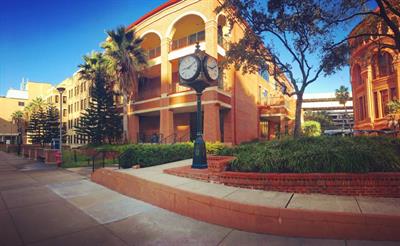
The start of the 2017-2018 academic year was a memorable one for UTMB students and faculty.
Just days after welcoming new students from all schools to campus at fall orientation, leaders in UTMB’s Academic Enterprise had the safety of students, faculty and staff in mind when they decided to cancel classes as Hurricane Harvey closed in on the Texas gulf coast. Classes were halted on Friday, Aug. 25; the hurricane made its first landfall between Port Aransas and Port O’Connor that night.
The storm slowly moved north along the Texas coast, flooding a large swath of Southeast Texas over the next few days. Student support groups were held throughout the time UTMB was on emergency status, and the Student Government Association turned its focus to helping community members by setting up the UTMB SGA Hurricane Harvey Relief Fund. University staff ensured that classroom and testing spaces were ready for the students’ return on Sept. 5.
In addition to ensuring the safety of students, academic leaders took action to preserve UTMB’s research mission. As a result of efforts before and during the storm, the university’s research enterprise had no damage and essentially had a smooth return to normal operations on Sept. 1.
UTMB’s Animal Resource Center (ARC) team evacuated all large animals to safe housing in central Texas, and relocated 2,800 cages of rodents and supplies to elevated facilities on the Galveston Campus. Veterinary technician Erika Main spent the night on campus to provide any necessary clinical care and husbandry support. A small group of facility supervisors, husbandry technicians and veterinarians also remained on-site every day to care for the animals: feeding, performing health checks and standing by in case clinical care was needed.
“Many of these individuals went above and beyond their prescribed duties to cover animal care over the weekend and during the peak of the storm in Galveston,” said Doug Brining, DVM, ARC director and attending veterinarian.
The institution’s research community also collaborated with Business Operations and Facilities staff members to identify buildings that would lose air-handling capabilities in a power outage. Working closely with departments located in the at-risk facilities, the university ordered and distributed dry ice to preserve freezers. And buildings were monitored throughout the emergency period to quickly identify and address any issues.
“Luckily, we escaped any institution-wide damage and this event let us test our emergency preparedness plan and lessons learned from Hurricane Ike,” said Toni D’Agostino, associate vice president for research administration. “And, because of everyone’s hard work, we passed the test.”